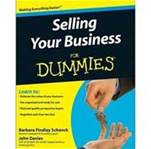How to Compile Financial Records to Prepare a Business For Sale
You will not get beyond the first glimmer of buyer interest unless you show financial records – and the more formally prepared and documented they are, the better your chances are for selling. In fact, how you present your financial information can affect the sale price of your business. If your business does not already have clean, presentable financial statements, you have two choices in front of you. Create financial statements using accounting software or hire a professional to do the job for you. If you decide to prepare your own statements, treat your work as a first draft for a professional review. This is a time in the life or you business where you should plan to make good use of your accountant’s expertise. The short cut of course is to head straight to an accountant for help. If that is the path you choose, then make sure you arrive armed with financial facts about your business in order to make the best use of the time.
Know what you need
The business you are selling may have a couple dozen employees in a sprawling office or shop; or you may have hundreds of employees and even multiple locations. No matter the size, financial records are important if you wish to sell a business.
Financial statements that go back three years. Offering to let a buyer go through a shoebox full of records will not do. You need to present financial statements that are accurate and understandable, including year-to-date and past three-year income statements, balance sheets, cash flow statements, and a statement of the seller’s discretionary earnings your business generates. Depending on the nature and size of the business, cash basis financial statements may be acceptable to a buyer. For most businesses an accrual basis financial statements are preferred.
Business Financial Trends. Financial statements bare the financial soul of your business, but they require interpretation before the information they contain can actually help you sell your business. That is why it is important to present at-a-glance trend charts and financial ratios that show what the numbers in your statements actually mean and the kind of opportunity they represent. Truth is with your financial statements in hand a prospective buyer has all the information necessary to plot the direction you sales and earnings are heading calculate what percentage of sales dollars make it to the bottom line and determine how efficiently your business turns inventory or collects receivables. You are better off doing the work yourself however so you can present the information with your own explanations about what the calculations mean and how they support the idea that your business is a good purchase opportunity.
Backup records. To back your financial claims you need to be ready to present supporting financial documents including bank statements, tax returns and other forms that prove that the numbers in your financial records are accurate.
Where to begin
Business owners are do-it-yourselfers, so your inclination may be to use whatever numbers you can come up with, prepare your own financial statements, and precede full steam ahead. For businesses with revenues in the several-hundred-thousand dollar range and with sales coming from easy-to-track sources, self-generated statements are more likely to be considered adequate. If you decide to go it alone, rely on good accounting software such as Peachtree or QuickBooks while keeping in mind accountant prepared statements underscore that your business is professionally managed, which can add value in the minds of buyers seeking businesses with sophisticated management systems.
Get advice about restating your balance sheet prior to the sale and remove assets that are not essential to the business operations such as a business-owned car, money market or investment accounts, buildings or other real estate property and loans.
Preparing financial statements
Buyers want to see four financial statements: an income statement, also known as a profit and loss statement, a balance sheet stating the financial condition of the business; a cash flow statement showing how money moves through the business and a seller’s discretionary earnings statement showing how much cash your business generates annually for the benefit of you, the owner.
- Income statement This calculates your net profit or your pretax net income also known as your bottom line. This statement shows how your company performed financially and shows money made or lost over recent years. This statement should contain gross sales, gross profit, and operating profit, which are the earnings before interest and taxes after you subtract the operating expenses and depreciation.
- Cash flow statement This statement shows how much money came into and went out of your business over the statement period and how your assets changed as a result. Total funds in including all money received from sales, dividends or interest from business investments or any other revenue made by the business. It should show funds out also, every cent the business paid out of the statement period.
- Seller’s Discretionary Earnings This statement combines information from your income statement and balance sheet with adjustments that back out certain expenses, including owner benefits, one time non recurring expenses and expenses that are considered discretionary meaning another owner may choose not to incur them and such a decision wouldn’t greatly harm the business. The result should be a report showing how much the business has earned annually for you. This process is called recasting or normalizing your financials. This is a standard process to show how much the business really earns. For example when running a business, you deduct everything possible allowing business expense ass a fair way to minimize profits and taxes. When it is time to sell however, you will want to show how much cash your business actually generates for a full-time owner/manager.
- The Balance Sheet This statement shows the value of everything your business owns – its assets – minus everything your business owes – its liabilities – as of certain moment in time, usually year-end or month-end. The balance sheet should show current assets such as investments, securities, accounts receivables, value of inventory, and importantly cash on hand. It should have the value of larger fixed assets like land, buildings, or major equipment. Intangibles are also important to show on a balance sheet for example a process your business invented or a special patent the business holds. The balance sheet also shows any current liabilities, long-term financial obligations, the owners’ equity and finally the sum of the total assets and total liabilities.
Know what buyers look for in your financial records
Financial trends and ratios. Buyers scan financial statements for success indicators or red flags. When they are looking to buy a restaurant, for example they know to check food, labor and rent costs as a percentage of sales. In service businesses, they check whether the net profit margin is holding steady to see if costs of sales and operating expenses are growing at a pace that is eating up the bottom line. Help buyers see the positive financial trends and ratios of your business, rather than making them dig through your financial statements to arrive at the calculations on their own.
Sales and expense growth. Buyers study recent history of revenues. The revenues tell a story, if they are declining, a buyer will assume that either your product or service has lost appeal in the marketplace. If sales are increasing, buyers have confidence that your business is doing something – or a lot of things right. Buyers also look at expenses to make sure costs are not rising fast than revenues. If sales have been on an upswing then show that to buyers in a chart or summary.
Sales and earnings growth rate. Buyers want to get a sense of what is in store for the next few years. Calculate a rate of growth by examining the sales and discretionary earnings. If sales have increased each year, then show this to a buyer in the form of a percent.
Inventory turnover. Buyers especially in manufacturing, retail, or distribution businesses will want to know the inventory turnover rate. This does vary depending on the industry but what is important is to know how the rate is trending. Has the inventory turned over at an increasingly rapid or slow rate? Generally, a high turnover is better than a low ratio because it can indicate business is good, inventory is well managed and selling quickly. However if you business inventory turnover is slow because you stocked up on materials just be prepared to include that information in the selling documents presented to buyers.
Receivables. Buyers want to assess the strength of the business by reviewing how long credit sales remain in accounts before paid. This can reveal two things: how efficiently your business manages receivables and the strength of clientele and how able or willing customers are to pay their bills.
Compiling Financials
Business brokers, accountants and other professionals can help when it comes time to prepare businesses financial records for sale. A buyer needs to see solid financial information to be confident in the purchase of your business. The ability to show proof of solid legitimate financial records can greatly affect the sale price of a business. So get your financial paperwork in order, choose an accounting method that works for your business, create reports or have a professional help prepare documents showing sale and earnings data and don’t forget to back up the information.





